|
Electrostatics
Electromagnetics
Electricity &
Magnetism
© The scientific sentence. 2010
|
RC circuits
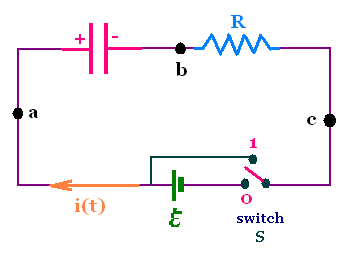
A capacitor is a device which can hold or contain
charge on its plates, charge +Q on one plate and
- Q on the other. The potential difference across
a charged capacitor is V = Q/C, where C is the
capacitance of the capacitor.
We examine two specific cases:
- Charging a capacitor: Switch on the position 0, and
- Discharging a capacitor: Switch on the position 1.
The circuit that contains a resistor and a capacitor is called
an RC circuit. Its main characteristic is the variation with
respect to time of the electric current across the circuit.
1. Charging a capacitor
Switch on the position 0
1.1. Charge and current
At the time the switch is closed, the battery begins
transferring charge carriers from one capacitor plate
to the other; and the current starts to circulate across
the circuit.
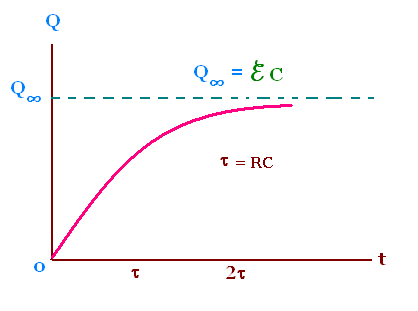
Beginning at the point c, the sense of the current is
clockwise, Kirchhoff's loop rule gives:
(Va - Vc) + (Vb - Va) +
(Vc - Vb) = 0
That is:
+ ℰ - (Q/C) - R I = 0
Q is the instantaneous charge on the positive plate of the
capacitor. Since I = dQ/dt, the rate at which the capacitor is
charging, we find:
ℰ = (Q/C) + R I = Q/C + R(dQ/dt)
dQ/dt = ℰ/R - Q/RC
dQ/(ℰ/R - Q/RC) = dt (Eq.1)
Let: ℰ/R - Q/RC = z , so
dz = - dQ/RC
The equation (Eq.1) becomes:
- RC dz/z = dt
thus
dz/z = - dt/RC
Integrating gives:
z = const . exp{- t/RC}
At t = 0, Q = 0, hence z = ℰ/R
Therefore
z = ℰ/R exp{- t/RC}
That is
ℰ/R - Q/RC = ℰ/R exp{- t/RC}
Rearranging, we find:
ℰ - ℰ exp{- t/RC} = Q/C
Solving for Q gives:
Q = ℰC[1 - exp{- t/RC}]
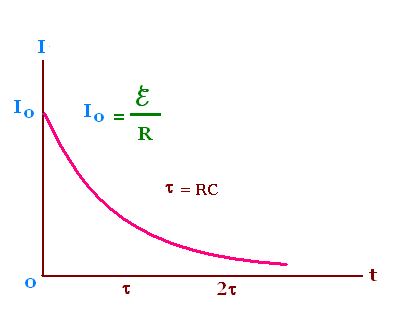
Taking the time derivative of the equation of Q gives:
I = dQ/dt = (ℰ/R)exp{- t/RC}
Let the initial current
Io = ℰ/R, and τ = RC the time constant.
Hence
I = Io exp{- t/RC}
Notice that the current Io is the
steady current that would exist in the capacitor
is replaced by a connecting wire.
Charging a capacitor:
Io = ℰ/R , τ = RC
Q = ℰC[1 - exp{- t/τ}] , I = Io exp{- t/τ}
As time goes on, t tends to ∞ the final charge
on the capacitor is Q∞ = ℰC.
The product τ = RC represents the rate at which the
capacitor is charged. This product of dimension time is
called time constant of the circuit.
1.2. Energy exchanged in the circuit
During the charging process of the capacitor,
energy is transferred by the emf ℰ of
the battery to the charges carriers of the circuit.
During the entire charging process of the capacitor
as t tends to ∞, the entire charge is Q∞.
The energy by unit charge transferred by the
battery is equal to its emf ℰ. During the entire
charging process the charge that passes through the battery is
Q∞. Hence, the energy transferred by the
battery, during the entire process of charging the capacitor, is:
ℰQ∞ = ℰℰC = ℰ2C.
Since the energy stored in the capacitor with the charge Q
is (1/2)Q2/C ; the energy stored in the capacitor
after the charging process is completed is:
Ecapacitor = (1/2)Q∞2/C =
(1/2)(ℰC)2/C = (1/2) C ℰ2.
Ecapacitor = Cℰ2/2
Thus half of the energy expended by the emf of the
battery is stored in the capacitor.
The other half of this energy is dissipated as heat
in the resistor. The rate at which energy is dissipated
in the resistor is P = - dU/dt = RI2, where U is
the electric potential energy of the carriers.
During the charging of the capacitor, the energy dissipated
is Eheat = - ΔU = - ∫dU = ∫RI2dt (from
0 to ∞) =
∫R Io2 exp{- 2t/τ} dt =
R Io2 ∫exp{- 2t/τ} dt.
Let x = 2t/τ thus dx = 2/τ dt
∫ exp{- 2t/τ} dt = (τ/2)∫exp{- x} =
- (τ/2) exp{- x} (from 0 to ∞) = (τ/2) . 1 = τ/2.
Therefore
Eheat = - ΔU = R Io2 . τ/2 =
R (ℰ/R)2 . RC/2 = (ℰ)2 . C/2
Eheat = Cℰ2/2
2. Discharging a capacitor
Switch on the position 1
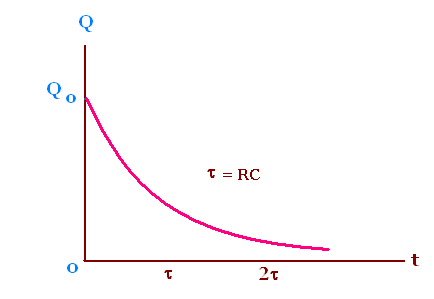
Initially the capacitor is under the potential difference
Vo, and has the charge Qo. The time we
disconnect it from the battery, the charge carriers begin to
flow through the circuit to discharge the capacitor. The flow
of these carriers constitutes a current in the circuit.
Let Q(t) be the charge on the capacitor at time t. The sense of the
current is counterclockwise, Kirchhoff's
loop rule gives:
(Va - Vb) + (Vc - Va) +
(Vb - Vc) = 0
That is
Q/C - R I = 0
Since I is positive and dq/dt is negative, because
the charge on the plates is decreasing, I = - dQ/dt. Rearranging, we have:
dQ/Q = - dt/RC
The indefinite integral gives:
Q(t) = const exp {- t/RC}
With Q(0) = Qo, we have const = Qo,
hence
Q(t) = Qo exp {- t/RC}
Q(t) = Qo exp {- t/RC}
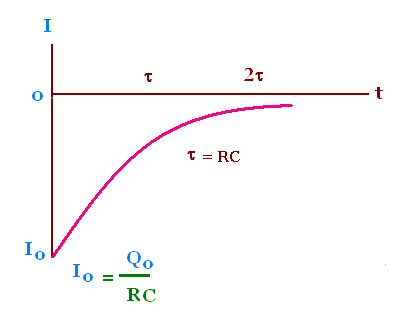
Taking the time derivative of the equation of Q gives:
I = - dQ/dt = (Qo/RC) exp {- t/RC}
Let the initial current
Io = Qo/RC = Vo/R,
and τ = RC the time constant that characterize the decay of
the current.
Hence
I = Io exp{- t/RC}
The current in the circuit decreases exponentially to zero.
Discharging a capacitor:
Io = Qo/RC = Vo/R, τ = RC
Q(t) = Qo exp {- t/τ} , I = Io exp{- t/τ}
|
|